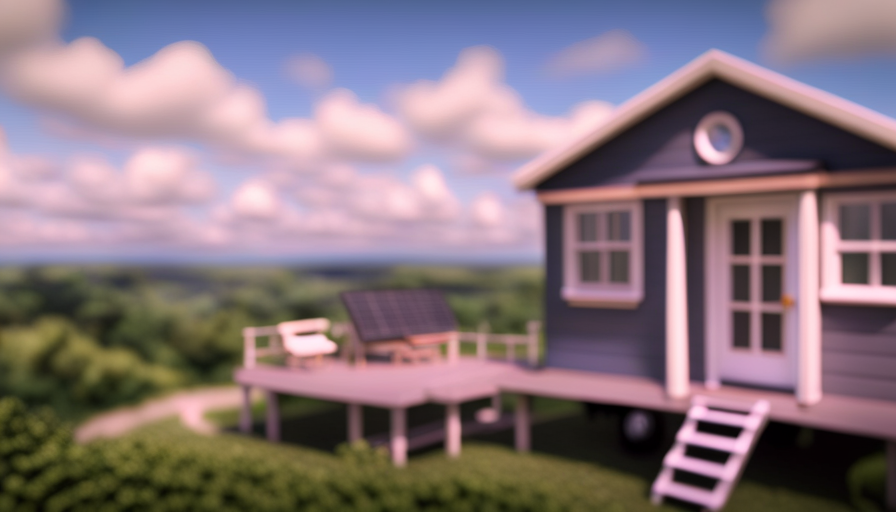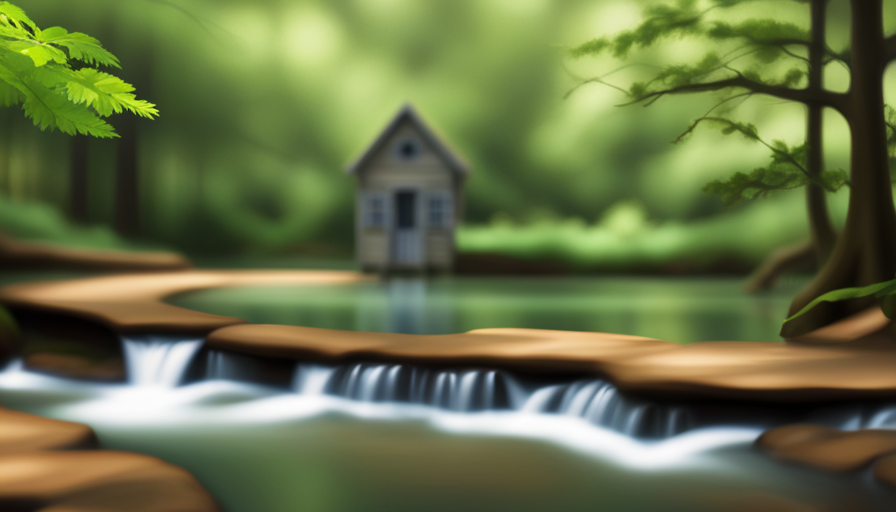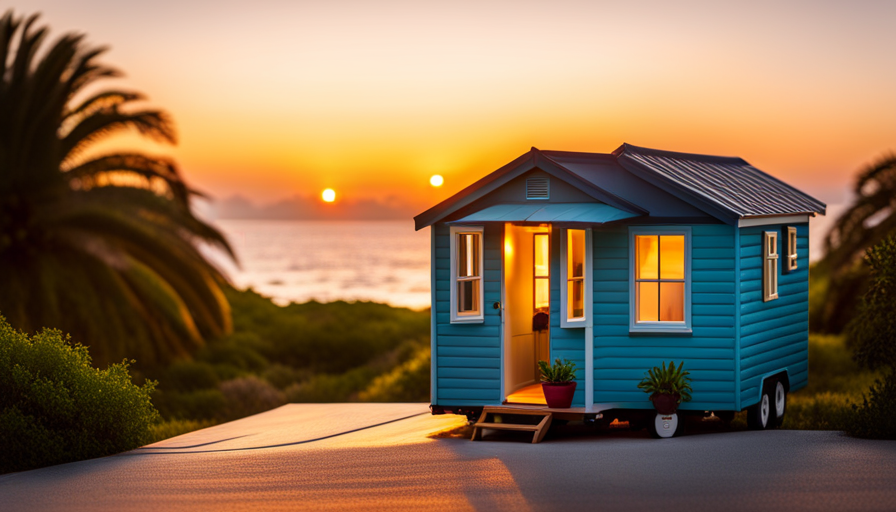As per the popular adage, ‘the best things arrive in petite packages,’ this holds especially true in the realm of eco-friendly living with the example of the Tesla Tiny House. For those inclined towards adopting a minimalist way of life and aiming to decrease their environmental impact, acquiring a Tesla Tiny House might just be the ideal answer.
In this article, I’ll guide you through the process of purchasing your very own Tesla Tiny House. From understanding the benefits and determining your budget to exploring different models and floor plans, we’ll cover it all.
We’ll also delve into the features and technology included, as well as the warranty and maintenance services you can expect.
Whether you’re a solo adventurer or a small family, there’s a Tesla Tiny House that can meet your space and living needs. So, let’s get started on this exciting journey towards a sustainable lifestyle. Get ready to make a difference and enjoy the comforts of a cozy, eco-friendly home on wheels.
Key Takeaways
- Consider financing options such as saving up, personal loans, RV loans, or lease-to-own programs when buying a Tesla Tiny House.
- Look for a reputable Tesla Tiny House dealer that offers competitive and transparent pricing, and schedule a visit or virtual tour to see the tiny house and discuss financing options.
- Review the warranty coverage and maintenance services provided by Tesla Tiny House to ensure peace of mind.
- Embrace a sustainable lifestyle by choosing a Tesla Tiny House equipped with eco-friendly appliances, energy-efficient lighting, and solar panels to reduce your carbon footprint.
Understand the Benefits of a Tesla Tiny House
You’ll be amazed at the endless possibilities and sustainable lifestyle that awaits you with a Tesla Tiny House. The sustainability factor of these compact homes is truly remarkable. Powered by solar energy, they’re designed to reduce your carbon footprint and help protect the environment.
Not only do they provide a comfortable living space, but they also minimize energy consumption and waste. Additionally, Tesla Tiny Houses are more affordable compared to traditional houses. With lower construction costs and maintenance expenses, you can save a significant amount of money.
Imagine living in a home that not only meets your needs but also allows you to contribute to a greener future.
Now that you understand the benefits of a Tesla Tiny House, let’s move on to determining your budget and financing options seamlessly.
Determine Your Budget and Financing Options
Figure out your budget and explore different financing options to make owning a Tesla tiny house a reality. When determining your budget, consider how much you can comfortably afford to spend on a tiny house. Take into account not just the purchase price, but also ongoing costs such as maintenance, insurance, and utilities.
To help you budget effectively, here are four financing options and budgeting strategies to consider:
-
Save up: Set aside a portion of your income each month until you have enough to purchase a Tesla tiny house outright.
-
Personal loan: Explore the option of obtaining a personal loan from a bank or credit union to finance your tiny house purchase.
-
RV loan: Some lenders offer specialized loans for tiny houses on wheels, similar to RV loans.
-
Lease-to-own: Look for lease-to-own programs that allow you to rent a Tesla tiny house with the option to purchase it in the future.
Once you have a clear budget and financing plan in place, you can move on to the next step of researching different models and floor plans.
Research Different Models and Floor Plans
Exploring various models and floor plans can provide a multitude of options for those interested in owning a compact, modern living space on wheels. Tesla offers a range of different designs to suit various preferences and needs. From sleek and minimalist to cozy and rustic, there is a Tesla tiny house for everyone. Additionally, Tesla provides customization options, allowing you to personalize your tiny house to your liking. Whether you prefer an open floor plan or separate rooms, Tesla has options to accommodate your desired layout. To further assist you in making an informed decision, I have included a table below showcasing four popular Tesla tiny house models and their key features.
| Model | Features |
|---|---|
| Model A | Spacious living area, separate bedroom, solar panels |
| Model B | Compact design, foldable furniture, energy-efficient appliances |
| Model C | Lofted sleeping area, large windows for natural light, off-grid capabilities |
| Model D | Multiple storage options, rooftop deck, smart home integration |
Considering different models and floor plans can help you determine the best fit for your space and living needs, which we will discuss in the next section.
Consider Your Space and Living Needs
When considering your space and living needs, it’s important to think about how you want to utilize your compact, mobile living space. Here are four key space considerations and lifestyle requirements to keep in mind when buying a Tesla tiny house:
-
Efficient Layout: Make sure the floor plan maximizes every inch of space, providing functionality and comfort.
-
Storage Solutions: Look for clever storage options like hidden compartments and built-in organizers to keep your belongings organized and easily accessible.
-
Multi-purpose Furniture: Opt for furniture that serves multiple functions, such as a sofa that can be transformed into a bed or a table that can be folded away when not in use.
-
Energy Efficiency: Consider the eco-friendly features, such as solar panels and energy-efficient appliances, to reduce your carbon footprint and save on energy costs.
With these space considerations and lifestyle requirements in mind, let’s now explore the features and technology included in the Tesla tiny house.
Explore the Features and Technology Included
Imagine stepping into your compact, mobile living space and being greeted by a plethora of innovative features and cutting-edge technology that enhance your comfort and convenience. When you explore the sustainability features of the Tesla Tiny House, you’ll be amazed at how it prioritizes eco-friendly living. From the solar panels on the roof to the energy-efficient appliances, this tiny house is designed to lower your carbon footprint. Additionally, the Tesla Tiny House offers smart home integration, allowing you to control various aspects of your living space with just a few taps on your smartphone. Imagine adjusting the temperature, turning on the lights, or even starting your electric vehicle charge, all from the comfort of your couch. It’s truly a seamless and efficient living experience. Now that you understand the incredible features and technology included, let’s find a trusted Tesla Tiny House dealer to make your dream a reality.
Find a Trusted Tesla Tiny House Dealer
Ready to embark on your journey to find the perfect sanctuary on wheels? Look no further than locating a trusted Tesla Tiny House dealer who will guide you every step of the way.
When searching for a dealer, it’s crucial to choose one that is reputable and experienced in selling Tesla Tiny Houses. Look for dealerships that have a proven track record of customer satisfaction and positive reviews. Additionally, consider the pricing trends of Tesla Tiny Houses to ensure you’re getting the best deal possible. Dealerships that offer competitive pricing and transparent pricing structures are ideal.
Once you’ve found a trusted dealer, you’ll be one step closer to owning your dream tiny house on wheels. Next, let’s explore how you can schedule a visit or virtual tour to see the Tesla Tiny House in person.
Schedule a Visit or Virtual Tour
After finding a trusted Tesla Tiny House dealer, the next step is to schedule a visit or virtual tour. This is an important part of the buying process as it allows you to get a firsthand look at the tiny house and ask any questions you may have.
One of the benefits of scheduling a virtual tour is that you can do it from the comfort of your own home, saving you time and travel expenses. Additionally, virtual tours provide a detailed view of the tiny house, allowing you to see every nook and cranny.
During the visit or virtual tour, the dealer can also discuss financing options with you, making it easier for you to determine the best payment plan for your budget.
Once you have completed the visit or virtual tour, you can then move on to reviewing the warranty and maintenance services.
Review the Warranty and Maintenance Services
When reviewing the warranty and maintenance services, it’s crucial to pay attention to the coverage and support provided. The warranty coverage should include protection for major components such as the battery, drivetrain, and electrical systems.
Additionally, it’s important to understand the duration and limitations of the warranty. Tesla offers a comprehensive warranty for their vehicles, typically covering 4 years or 50,000 miles, whichever comes first. They also provide extended warranty options for further peace of mind.
As for maintenance, Tesla recommends a regular service schedule to ensure optimal performance and longevity of the tiny house. This may include inspections, software updates, and replacements of certain parts. The maintenance schedule can vary depending on usage, so it’s essential to discuss this with Tesla representatives.
Understanding the warranty coverage and maintenance schedule will help you make a final decision and place your order smoothly.
Make a Final Decision and Place Your Order
To solidify your choice and proceed with your purchase, it’s worth verifying the validity of a theory that has caught the interest of many. How about we take a closer look at the final steps of buying a Tesla tiny house? Firstly, you need to finalize your order and consider the payment options available to you. Tesla offers various payment methods, including financing options and leasing plans, making it easier for you to own your dream tiny house. To make the process more engaging, here’s a table summarizing the different payment options:
| Payment Option | Description | Benefits |
|---|---|---|
| Financing | Monthly installments with interest rates | Spread out the cost over time and enjoy ownership sooner |
| Leasing | Lower monthly payments with the option to upgrade | Flexibility to upgrade to a newer model once your lease term ends |
| Outright purchase | Paying the full cost upfront | No monthly payments or interest charges, immediate ownership of the Tesla tiny house |
With your order finalized and payment option chosen, you are now ready to prepare for delivery and enjoy your new sustainable lifestyle. Transitioning seamlessly into the next step, let’s explore how to get ready for the arrival of your Tesla tiny house.
Prepare for Delivery and Enjoy Your New Sustainable Lifestyle
Get ready to embrace a sustainable lifestyle as you prepare for the arrival of your eco-friendly dream home. Once you’ve made the final decision and placed your order for a Tesla tiny house, it’s time to focus on the delivery logistics and getting everything ready for your new sustainable lifestyle.
Tesla will work with you to coordinate the delivery of your tiny house to your desired location. They’ll ensure that the transportation process is smooth and efficient, so you can start enjoying your new home as soon as possible.
As you wait for the delivery, you can begin envisioning your sustainable lifestyle. Tesla tiny houses are equipped with eco-friendly appliances, such as energy-efficient lighting and solar panels. These features will help you reduce your carbon footprint and live more sustainably.
Embrace the possibilities and get ready for a greener future!
Frequently Asked Questions
Can I customize the floor plan and design of my Tesla Tiny House?
Yes, you can absolutely customize the floor plan and design of your Tesla tiny house. Tesla offers a range of customization options to suit your preferences and needs. From choosing different layouts and room sizes to selecting materials and finishes, you have the freedom to create a personalized space. The interior design possibilities are endless, allowing you to make your tiny house truly unique and tailored to your taste.
What are the energy efficiency features of a Tesla Tiny House?
The energy efficiency features of a Tesla tiny house are designed to maximize cost effectiveness. The house is equipped with solar panels that generate clean and renewable energy, reducing reliance on the grid. Additionally, it utilizes energy-efficient appliances and LED lighting to minimize energy consumption.
The tiny house also includes a state-of-the-art insulation system to maintain comfortable temperatures while minimizing heating and cooling costs. Overall, these features make the Tesla tiny house an environmentally friendly and cost-effective choice for sustainable living.
Are there any additional costs associated with owning a Tesla Tiny House?
Yes, there are additional costs associated with owning a Tesla tiny house. In addition to the initial purchase price, there may be ongoing maintenance expenses to consider. These could include regular cleaning, repairs, and any necessary upgrades or replacements.
It’s important to budget for these costs to ensure the continued functionality and longevity of your Tesla tiny house. Proper maintenance can help maximize its energy efficiency features and overall performance.
Can I finance my Tesla Tiny House through Tesla’s financing options?
Absolutely! Tesla offers a range of financing options that can make owning a Tesla Tiny House a reality. With flexible terms and competitive rates, you can find a plan that suits your needs.
And the best part? You can customize your tiny house to your heart’s content, creating a space that truly reflects your style and preferences.
So go ahead, dive into the world of Tesla Tiny Houses and make your dream home a reality!
How long does it typically take for a Tesla Tiny House to be delivered after placing an order?
Typically, the delivery time for a Tesla Tiny House after placing an order is around 6-8 weeks. However, it’s important to note that this can vary depending on factors such as location and demand.
Customer reviews of the delivery process have generally been positive, with many noting that their Tesla Tiny House arrived within the estimated timeframe. Tesla strives to provide timely and reliable delivery service to ensure customer satisfaction.
Conclusion
In conclusion, purchasing a Tesla Tiny House isn’t just a transaction, but a transformative experience. By investing in a sustainable lifestyle, we’re taking a step towards a greener future.
It’s not a coincidence that Tesla’s innovative technology and eco-friendly features align perfectly with our desire to live in harmony with the environment. So, let’s embark on this journey together, where convenience, luxury, and sustainability intertwine.
With our new Tesla Tiny House, we can truly make a positive impact and create a meaningful change in the world.
Hi, I’m Emma. I’m the Editor in Chief of Tiny House 43, a blog all about tiny houses. While tree houses are often associated with childhood, they can be the perfect adult retreat. They offer a cozy space to relax and unwind, surrounded by nature. And since they’re typically built on stilts or raised platforms, they offer stunning views that traditional homes simply can’t match. If you’re looking for a unique and romantic getaway, a tree house tiny house might just be the perfect option.










